
Publisher:
Bonnie King
CONTACT:
Newsroom@Salem-news.com
Advertising:
Adsales@Salem-news.com

~Truth~
~Justice~
~Peace~
TJP
Apr-06-2010 17:42

 TweetFollow @OregonNews
TweetFollow @OregonNews
Down the Drain
Eddie Zawaski Salem-News.comPutting in a new drain field was never at the top of my list of the ten most entertaining things to do...
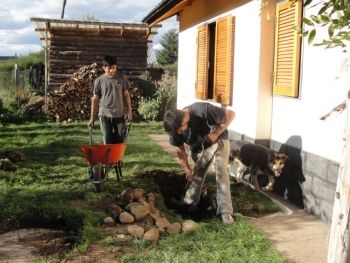 Photos: Eddie Zawaski and Gail Parker |
(PATAGONIA, Argentina) - Summer ended last night on the 31st of March at four in the morning. That’s when a huge thunderbolt smacked into our house turning on lights before the breaker switch kicked off. I jumped out of bed to see what had happened as the bang and light had at first appeared to me as signs of a break-in.
Creeping along the dark hallway, I noticed that there streetlights on in the barrio, but no lights on in my house. The little temp control light on the gas furnace was out, a sure sign of power failure. Sure enough, the breaker was tripped. As I stood before it pondering my next move, I heard a load roar outside and above me. It sounded like I was standing next to a waterfall and when I looked out the window it looked like that too.
The water had suddenly started coming down in a deluge that was dropping water about as fast as any cloud can possibly manage. I could see long streamlets of water bouncing off the rocks on our street. It had become an instant river churning its way south to Lago Pluelo. This went on for thirty minutes or more until it paused and then resumed at a slower but still heavy rate.
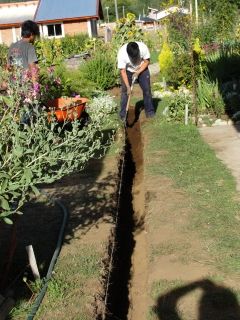
These thunderstorms, which would continue on into the next day, were a season-changer. I counted myself lucky to have finished covering up my drain field just eight hours before the downpour arrived.
Putting in a new drain field was never at the top of my list of the ten most entertaining things to do, but it had made it to the top of the list of the ten most necessary things to do. We had been having problems with our household septic system for nearly a year and the situation did not seem improved in dry summer weather.
We had a spongy section of yard outside our bedroom window that grew lush tall grass without water and monstrous flowers around its margins. The toilet gurgled constantly and occasionally refused to carry off a deposit if the washing machine had been running that day. It was late January when we got our septic tank pumped out for the second time in six months.
El Pamperito, also known as El Tucan, is the only game in town when it comes to getting a septic tank pumped in El Bolson. This ancient lumbering tanker/pumper winds its way through every barrio, slurping up sludge and dumping who knows where. The Pamperito crew came and sucked out all the water from my septic tank and the drain lines beyond that had been flooded.
The crusty paisano who operates the old pumper remembered that he had drained me out just six months earlier. He said it was “demasiado poco tiempo” between pumpings and I had better think about dealing with my problem. He did not remember, however, that he had charged me 150 pesos six months earlier and tried to lay claim on 180 now.
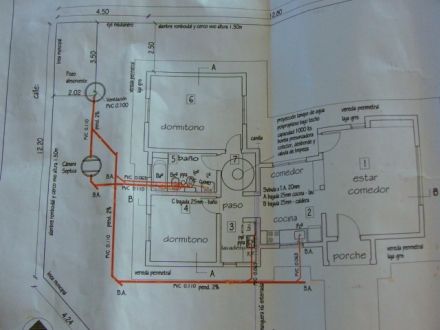
When I protested he simply smiled and said, “150, como siempre.” Also, to show me he was a good guy and had my best interests at heart, he said he would recommend the names of some “buenos chicos” who could help me out. He handed me a slip of paper with a phone number and the letters SR and SM on it.
Before I could get going on my errands to town the next morning, the guys with SR and SM showed up at my door. I hadn’t called them, but apparently El Pamperito had urged them to see me. Juan, the big bearded bear, and Eziquiel, the wiry one, had an offer ready.
They had come with a proposal to replace my septic system with a new high-tech state-of-the-art waste disposal unit that would surely solve all my problems for a mere 6500 pesos, installation included. It sounded expensive but tempting, a little too good to be true.
I told them I would consider their offer after I checked it out thoroughly and considered the alternatives.
Unfortunately, the website for the manufacturer of SM & SR’s super septic system had scant details and I was unable to assess this for it’s potential to solve my problems. I passed the information I had on it to a person I knew in Oregon who is an expert in matters of household waste disposal and he informed me that the super septic was really quite ordinary. It seemed that my local septic repair guys were selling an ordinary septic tank filled with some sort of super bacteria that ate down all the solids.
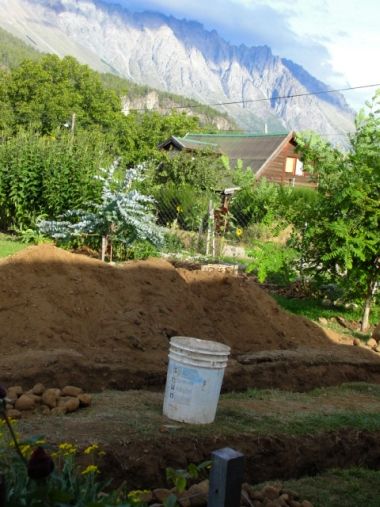
Solid waste wasn’t my problem. I was growing a swamp outside my bedroom window; water was my problem. My Oregon expert pal suggested that I think instead about some way to run all the grey water off somewhere else so my current septic system could work properly. He suggested a book on grey water treatment which I promptly ordered sent out from the US via another friend in Portland. I went into a frenzy of study of my current situation and its potential solutions.
My grey water option hit a wall when I tried to work out the connections for all the drains from my house. I had the set of plans for the septic system and the water drains that had been drawn up by the architect who designed our house, but nothing was as it was drawn.
The septic tank that El Pamperito had pumped was turned 90 degrees from the one that was drawn on the plans and the pipes entered in different places. When I went looking with my shovel for the waterlogged dry well shown in the drawing, it was nowhere to be found. I panicked. What if it had sunk? I really didn’t know if it would be possible to separate out the grey water. I asked the neighbors what they had done.
Sure enough, nearly everyone in the barrio had gone through similar experiences with backed up septics and resulting mini-wetlands. My neighbor across the street started having problems after she got a washing machine and deals with it by having El Pamperito come and pump her out whenever her system gets too full, twice a month in our wet winters. Another neighbor down the street told me I needed a “drenaje” (drain) and told me just how he had constructed his.
He dug a pit four meters by three and one and a third deep and filled it with boulders, placed a perforated pipe over the rock, covered with black plastic and backfilled with dirt. Several others had done the same. My Oregon septic wise man, however, suggested that the type of drain my neighbors had been employing was somewhat problematic, probably not treating the effluent properly. There were probably an unknown number of homes in our barrio pumping e-coli and other ugly stuff into the groundwater and I had no desire to add my name to that list.
I decided the best course would be to construct a new drain for my septic but do it on advice from people I knew and trusted back in the Pacific Northwest. It appeared to me that the general state of household waste disposal here in El Bolson was approximately the same as what it had been in the US a half-century ago when I was a child.

I remembered the neighborhood I had grown up in in Huntington, New York and all the problems that everyone had with failed septic systems. Many of the houses around us had “seepage pits” that filled up, made swamps and stunk up the neighborhood until a crew of workers would come out and dig them up and put in long drain lines across the lawns. My father said the problem was that underground water was too close to these pits and that’s why they filled up. My mother hissed the word “cesspool” with the same hate and derision her Eastern European forebears used for the word “cossack”.
On Long Island in the 50’s, no one really knew how or have the means to construct a septic system that would work for any length of time. They had simply dug pits without much of a plan and had hoped for good luck or the immanent arrival of a sewer. This was exactly the same problem I was facing here in Patagonia a half-century later. Moreover, the problem in Patagonia is exacerbated by flimsy building codes.
Our builder was required to file a plan with the municipality for a septic system, but there were two big holes in this process. First, it seems that any old plan will do to satisfy the local authorities and secondly, there are no building inspectors here who might come out and see that the builders are not following their plan. Our builder had just slapped in something convenient, hoping it would last until the sewer came.
I had to make a drain because the sewer was clearly not coming. There was certainly enough houses in our barrio to warrant the construction of a sewer line out here, but conditions would not permit that to happen. The current municipal administration is exceedingly corrupt and had squandered all available resources in other directions leaving nothing for a sewer line for our barrio.
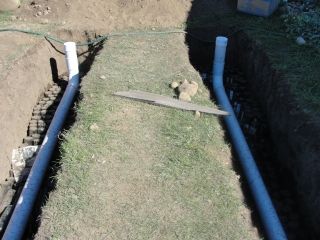
We had a great fireworks display at the hops festival last month and they raffled off a building lot in our barrio, one of the ones that floods. It costs the town government nothing to draw lines on a map and give away deeds, but backing up those deeds with the development of public infrastructure is an expensive proposition best left for future politicians to deal with.
First on the list for those future politicians is the currently operating sewer treatment plant in El Bolson, itself overloaded and creating problems for our neighbors. The community of Lago Puelo, a few miles downstream from our wastewater plant in El Bolson has a pending lawsuit against our town for damages due to groundwater contamination.
Even if the sewer were to come tomorrow, I would question the advisability of hooking up to a line that only contributed to the misery of our neighbors to the south and polluted the big lake. With the help of Robert, the environmental expert and Mark, an engineer friend, I would construct a drain that would not only dry up my swamp but clean up my effluent as well.
Using email and skype, I could talk with these folks, send pictures and drawings back and forth thus working out a consultation just as effective as if they were right here with me in the southern Andes. Mark told me how to do a five-gallon bucket percolation test.
I chose a suitable location and dug a test hole. Since the ground is lower on the east side of the house, I would have to make my new drain with a long connecting line to the septic tank on the west side of the house.
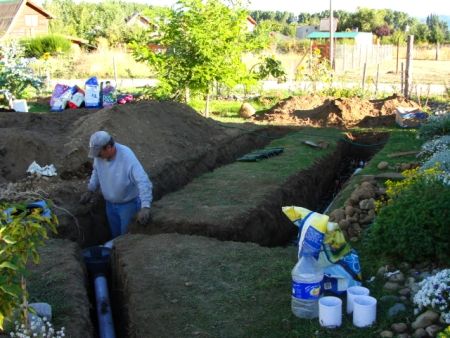
Also, the space on the east side of the house was more open, drier, and had the apparent potential to handle all the waste water coming out of our home. It would also keep the entire septic and drain system confined to the single lot that the house was constructed on, leaving our other two lots open for future construction or sale. My test hole was filled and primed and then showed that the rate of drainage of water into the sub soil was more than adequate to support a septic drainage system. After calculating my water usage and the amount of space necessary to handle the flow, I plotted out two large drainage pits and began digging.
It took me four days to dig out a pit five meters long, a meter deep and a little more than a half-meter wide. The second week in March is still hot here in El Bolson and it was just not possible to dig heavy dirt for too many hours in the day or too quickly at least not for a sixty-three year old. By the time my first pit was done, I was beginning to panic. Another pit and the long connecting line would take much more time, time I didn’t think I had until the fall rains would start making construction more difficult and perhaps impossible. Clearly, I needed help. I tried calling the SM & SR crew, the guys who had offered to install the high-tech super septic. They came right out to make a proposal.
At first, they agreed to do everything as I had planned things out. My local recycler had suggested I use old wine bottles instead of rocks or gravel at the bottom of my drains and the sewer rats agreed to doing it this way. They did, however, object to the labels on the bottles and suggested that I would need to remove them before putting the bottles down under. Removing all these labels would be a huge project just on its own, but once I started, I realized how necessary it was.
More than half the labels were either plastic coated or impregnated with plastic and would surely end up on the bottom as mat that could plug up my drain and render the entire project useless. I would have to do all the soaking and scraping to get these labels off.
They also agreed to dig out the trenches and lines as I had specified, but warned that my design may not have been deep enough and that additional digging might entail additional cost. For 2000 pesos (about $520) they said they could complete my job and make it quick, two or three days. While I was initially tempted by this offer, it seemed just a bit too open-ended and I was not looking forward to having to make and pay for changes on the fly. I said no to the sewer rats a second time and went over to see my neighbor, Diego Ventura, for help.
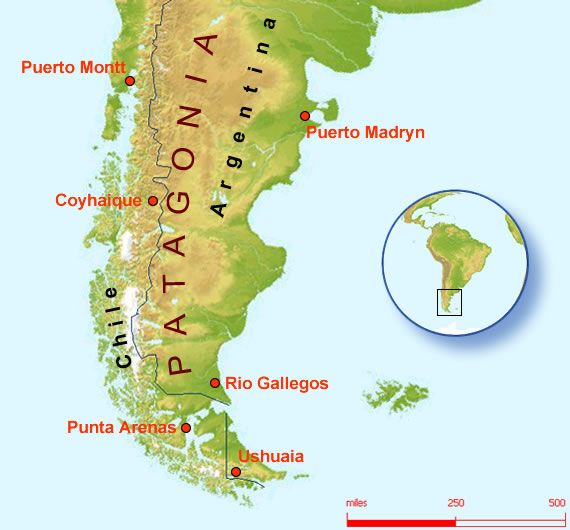
Diego has two sons, twenty-one year old twins, who are living at home and presently unemployed. They had been working over the summer, but with the tourists gone they had no more work and time on their hands. Diego had suggested to me earlier that the boys, Diego and Emiliano, had helped him dig out his drain and could do the same for me. When I brought up this possibility to the boys, they quickly agreed to help and said they would do so for nothing as a gesture of good will to a neighbor.
I don’t think they realized just how much digging would be necessary to complete this project. I insisted on paying them 20 pesos per hour to dig up my place. With that, they agreed to come around for eight of the next ten days to dig for two and a half hours each day. My part would be clean up and install all the bottles, put together all the pipes and make the connections. We would take longer than SM & SR, but the job would be less complex.
As the boys got to work making the second drain pit, I set about looking for the connection that I would make with the old sewer drain. Instead of digging around for a dry well that I knew was not there, I started digging out from the septic tank outlet toward whatever might lay beyond. About a meter beyond the tank and under two feet of saturated dirt, I found the connection to the old drainage pit and the grey water line.
My excavation showed that instead of a seepage pit or dry well, a septic drain just like my neighbor’s had been dug out to the edge of the property line. I could clearly see the big pipe covered by black plastic and buried amongst big rocks just like the drain that Diego had described. I could also see that the drain line was submerged in standing water. Since the septic and the drain downstream had been pumped out a month earlier, the water level had risen back up in the drain so that the toilet was gurgling again and the tub and shower drained painfully slowly. I immediately called the old guy with the pumper back to the house to evacuate my system again so I could dig the pipes out to hook them up to my new drain.
El Pamperito was delighted to have me as a customer again. He would have no trouble getting at the lid to my septic as it was already uncovered from the previous pumping. As soon as he got the water level in the septic tank down below the outlet, drain water came pouring back into it from the saturated drain field.
He estimated that he drew off twice as much water from the drain field as there had been in the septic tank. The water level in the drain dropped nearly four inches to the bottom of the big drain pipe.
My septic pumper surveyed my half-finished drain project and pointed out that my new exit pipe was not low enough. I would need another foot or more in all my drains and the connecting lines to ensure that my waste could flow downhill. This realization was especially depressing because I would not be able to dump any more waste water into the system until I made my connection unless I was willing to work under water. I had to work fast or do something else. I chose to do something different.
The connection between my septic and grey water at the drain suggested that all the grey water entered right there and may possibly be available further back along the line for a separate connection to my new drain. I dug out a hole close to the house where I thought the grey water lines might come to some final connection and sure enough found the y connector for the two lines a full 20 centimeters (eight inches) higher than the connection to the septic drain.
I calculated the difference in the levels of the bottoms of the this drain line and my new drain at the other side of the house and found I could have a drop of 13 inches over about 80 feet of line.
I needed, however, to be sure that the line I was looking at had all the grey water, something I could not be certain of since nothing was made according to the plan that was laid. I called the guy who had built the house and installed the original septic to come out and offer his opinion as to where things really were.
After Cesar Abraham came out and confirmed that I was actually looking at my complete grey water load alongside the house, the boys and I went into high gear. I spent all of the next five days, stripping bottles, laying pipe and hunting down essential parts like a distribution box to insure that effluent would flow evenly between both drains.
The boys dug contentedly in the afternoon heat of the dwindling summer. By the time we were ready to hook the lines together, summer had been gone a week and I had gone that long without being able to bathe or do laundry. On the 27th of March, I cut the pipe that connected my grey water to the septic drain and connected my grey water to the new drain.
I let my household waste water flow freely into the new open drain for three days. There were still bottles to add to the pit and adjustments to be made to the drain lines and distribution point to assure that water flowed evenly to both sides.
Friends and neighbors stopped by to see how old bottles worked with new wine. Once I was certain that everything was working as planned, I invited Diego and Emiliano back for covering. The boys never worked harder than they did on that final day.
By the end of the day on the next to last day of the month, under darkening clouds, the drain pits and feeder lines were covered with a fluffy layer of dry dirt. When the torment came that night it reduced the little three inch high mound of dirt over the drain lines and vaults to two-inch deep swales ready for more fill.
In the week or so since my drain has been installed, I have rejoiced repeatedly over simple things like watching the water swirl down in the toilet and seeing the little whirlpool at the drain when the bath tub empties. The total cost of the project came in around $500. That includes $200 paid to the boys for digging and $300 for materials.
The most important and expensive item was my distribution box which cost nearly $100 by itself. The three pick-up loads of wine bottles had cost less than half that. The best part of using old wine bottles was seeing the giant grin on the face of Tito, the recycler, every time he came out with a load of bottles.
He was genuinely proud of being able to bring some of his recycled product full circle and would give me “dos pulgadas arriba” (two thumbs up) every time he came. On the last trip out, Tito put his arm around my shoulder and whispered that when I am done with this project, I can use some more of his old wine bottles to build a greenhouse.
I’m thinking about it.
Articles for April 5, 2010 | Articles for April 6, 2010 | Articles for April 7, 2010
Salem-News.com:





Terms of Service | Privacy Policy
All comments and messages are approved by people and self promotional links or unacceptable comments are denied.
eddie zawaski April 7, 2010 6:52 am (Pacific time)
Thanks, Vic, for putting the presence of the British in its proper perspective. The controversy over sovereignty of the Malvinas is only the tip of the iceberg of British interference in Argentine affairs. Most folks in the USA don't know that Great Britain invaded Argentina twice in the nineteenth century. They followed up their military incursions with a nearly complete economic dominance of Argentine life by the 1930's. Most of the modern infrastructure of Argentina, the roads, railways, electrical grid and the sewers of Buenos Aires, were built by the British. This was done, however, at great cost to Argentines as these massive public works were financed by British banks who converted the coast into a debt load that Argentines could not possibly pay. Seventy years after the work was done, Argentina was still paying on the debt it owed to those British banks. To Roto I would say that I do now have a sanitary lifestyle without the help of Great Britain or high technology. According to my advisors in Oregon, I have achieved a solution that is effectively cleaning my waste. The sand filter system that Roto mentions is available down here in a version made in Argentina. I simply did not want to make a high tech solution to a problem that could be fixed more simply and appropriately. Why use a chain saw to cut butter?
Natalie April 6, 2010 11:08 pm (Pacific time)
LOL Vic: you seem irritated. Anyhow, I was told not once that Britain has very nice houses that don't get rotten for many years. It's a small, but very important detail on every man's "dream list", isn't it? BTW, mountains look nice.
Vic April 6, 2010 9:24 pm (Pacific time)
I would pray that "the Brits" stay the hell away. They seem to destroy or somehow ruin or diminish everything they touch. Can anyone name one good thing from Britain? The food? NO. The beautiful people? Not on your life. All their contributions to mankind? I cannot think of many, unless you count brutal colonization and world wide theft and plunder. Great pictures ! Enjoyed the article ! It was nice to see pictures of your home.
Roto April 6, 2010 6:12 pm (Pacific time)
Possibly if Argentina pushes the matter on the Falkland Islands, the British can come into your area and build ya a sewer system. Though approximately 45% of homes and businesses in the states are on a septic system there have been huge advances. There is a system now far superior to the sand filter system which can pump the waste (which will have been cleaned via the dozing tank and filtering) so you can avoid the problem you are now having, which sounds like you will never really get it fixed in the current way you are doing it. I would pray that the Brits take over and you can have a sanitary lifestyle. Payers for you.
[Return to Top]©2025 Salem-News.com. All opinions expressed in this article are those of the author and do not necessarily reflect those of Salem-News.com.